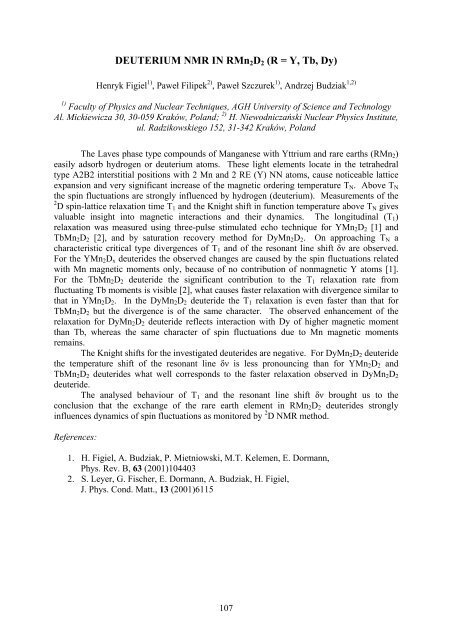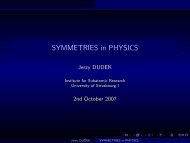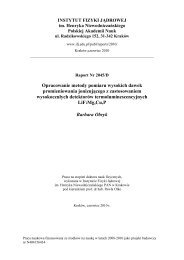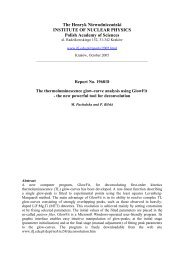Report No xxxx - Instytut Fizyki JÄ drowej PAN
Report No xxxx - Instytut Fizyki JÄ drowej PAN
Report No xxxx - Instytut Fizyki JÄ drowej PAN
Create successful ePaper yourself
Turn your PDF publications into a flip-book with our unique Google optimized e-Paper software.
DEUTERIUM NMR IN RMn 2 D 2 (R = Y, Tb, Dy)<br />
Henryk Figiel 1) , Paweł Filipek 2) , Paweł Szczurek 1) , Andrzej Budziak 1,2)<br />
1) Faculty of Physics and Nuclear Techniques, AGH University of Science and Technology<br />
Al. Mickiewicza 30, 30-059 Kraków, Poland; 2) H. Niewodniczański Nuclear Physics Institute,<br />
ul. Radzikowskiego 152, 31-342 Kraków, Poland<br />
The Laves phase type compounds of Manganese with Yttrium and rare earths (RMn 2)<br />
easily adsorb hydrogen or deuterium atoms. These light elements locate in the tetrahedral<br />
type A2B2 interstitial positions with 2 Mn and 2 RE (Y) NN atoms, cause noticeable lattice<br />
expansion and very significant increase of the magnetic ordering temperature T N . Above T N<br />
the spin fluctuations are strongly influenced by hydrogen (deuterium). Measurements of the<br />
2 D spin-lattice relaxation time T 1 and the Knight shift in function temperature above T N gives<br />
valuable insight into magnetic interactions and their dynamics. The longitudinal (T 1 )<br />
relaxation was measured using three-pulse stimulated echo technique for YMn 2 D 2 [1] and<br />
TbMn 2 D 2 [2], and by saturation recovery method for DyMn 2 D 2 . On approaching T N a<br />
characteristic critical type divergences of T 1 and of the resonant line shift δν are observed.<br />
For the YMn 2 D x deuterides the observed changes are caused by the spin fluctuations related<br />
with Mn magnetic moments only, because of no contribution of nonmagnetic Y atoms [1].<br />
For the TbMn 2 D 2 deuteride the significant contribution to the T 1 relaxation rate from<br />
fluctuating Tb moments is visible [2], what causes faster relaxation with divergence similar to<br />
that in YMn 2 D 2 . In the DyMn 2 D 2 deuteride the T 1 relaxation is even faster than that for<br />
TbMn 2 D 2 but the divergence is of the same character. The observed enhancement of the<br />
relaxation for DyMn 2 D 2 deuteride reflects interaction with Dy of higher magnetic moment<br />
than Tb, whereas the same character of spin fluctuations due to Mn magnetic moments<br />
remains.<br />
The Knight shifts for the investigated deuterides are negative. For DyMn 2 D 2 deuteride<br />
the temperature shift of the resonant line δν is less pronouncing than for YMn 2 D 2 and<br />
TbMn 2 D 2 deuterides what well corresponds to the faster relaxation observed in DyMn 2 D 2<br />
deuteride.<br />
The analysed behaviour of T 1 and the resonant line shift δν brought us to the<br />
conclusion that the exchange of the rare earth element in RMn 2 D 2 deuterides strongly<br />
influences dynamics of spin fluctuations as monitored by 2 D NMR method.<br />
References:<br />
1. H. Figiel, A. Budziak, P. Mietniowski, M.T. Kelemen, E. Dormann,<br />
Phys. Rev. B, 63 (2001)104403<br />
2. S. Leyer, G. Fischer, E. Dormann, A. Budziak, H. Figiel,<br />
J. Phys. Cond. Matt., 13 (2001)6115<br />
107

















